Comprehensive Site Inspection Report: WHS Compliance Evaluation
VerifiedAdded on 2023/06/12
|15
|2909
|54
Report
AI Summary
This site inspection report evaluates the implementation of risk controls by contractors, aligning with the work health and safety (WHS) management plan assessment. The inspection benchmarks safety practices against a checklist, acknowledging the dynamic and complex nature of construction sites. Key areas of focus include training, risk management, general safety requirements, the work environment, first aid provisions, sheds, protection measures like hoarding and edge protection, scaffolding, demolition procedures including asbestos handling, excavation safety, electrical safety, formwork inspections, hazardous substances management, manual tasks, welding safety, and the use of safety nets. The report assesses compliance with specific criteria in each of these areas, noting observations, ratings, and any demerits, to determine an overall pass/fail result.
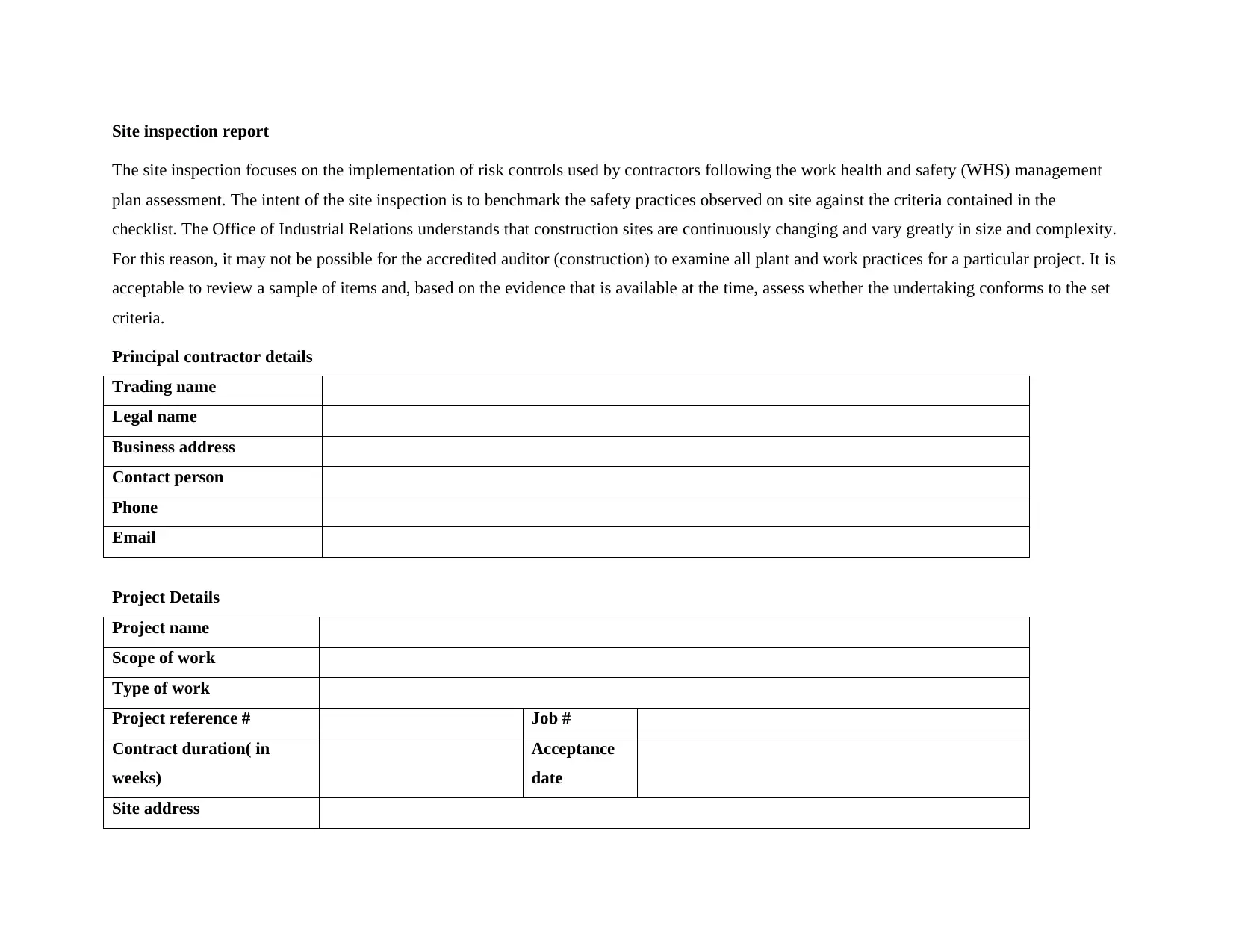
Site inspection report
The site inspection focuses on the implementation of risk controls used by contractors following the work health and safety (WHS) management
plan assessment. The intent of the site inspection is to benchmark the safety practices observed on site against the criteria contained in the
checklist. The Office of Industrial Relations understands that construction sites are continuously changing and vary greatly in size and complexity.
For this reason, it may not be possible for the accredited auditor (construction) to examine all plant and work practices for a particular project. It is
acceptable to review a sample of items and, based on the evidence that is available at the time, assess whether the undertaking conforms to the set
criteria.
Principal contractor details
Trading name
Legal name
Business address
Contact person
Phone
Email
Project Details
Project name
Scope of work
Type of work
Project reference # Job #
Contract duration( in
weeks)
Acceptance
date
Site address
The site inspection focuses on the implementation of risk controls used by contractors following the work health and safety (WHS) management
plan assessment. The intent of the site inspection is to benchmark the safety practices observed on site against the criteria contained in the
checklist. The Office of Industrial Relations understands that construction sites are continuously changing and vary greatly in size and complexity.
For this reason, it may not be possible for the accredited auditor (construction) to examine all plant and work practices for a particular project. It is
acceptable to review a sample of items and, based on the evidence that is available at the time, assess whether the undertaking conforms to the set
criteria.
Principal contractor details
Trading name
Legal name
Business address
Contact person
Phone
Project Details
Project name
Scope of work
Type of work
Project reference # Job #
Contract duration( in
weeks)
Acceptance
date
Site address
Paraphrase This Document
Need a fresh take? Get an instant paraphrase of this document with our AI Paraphraser
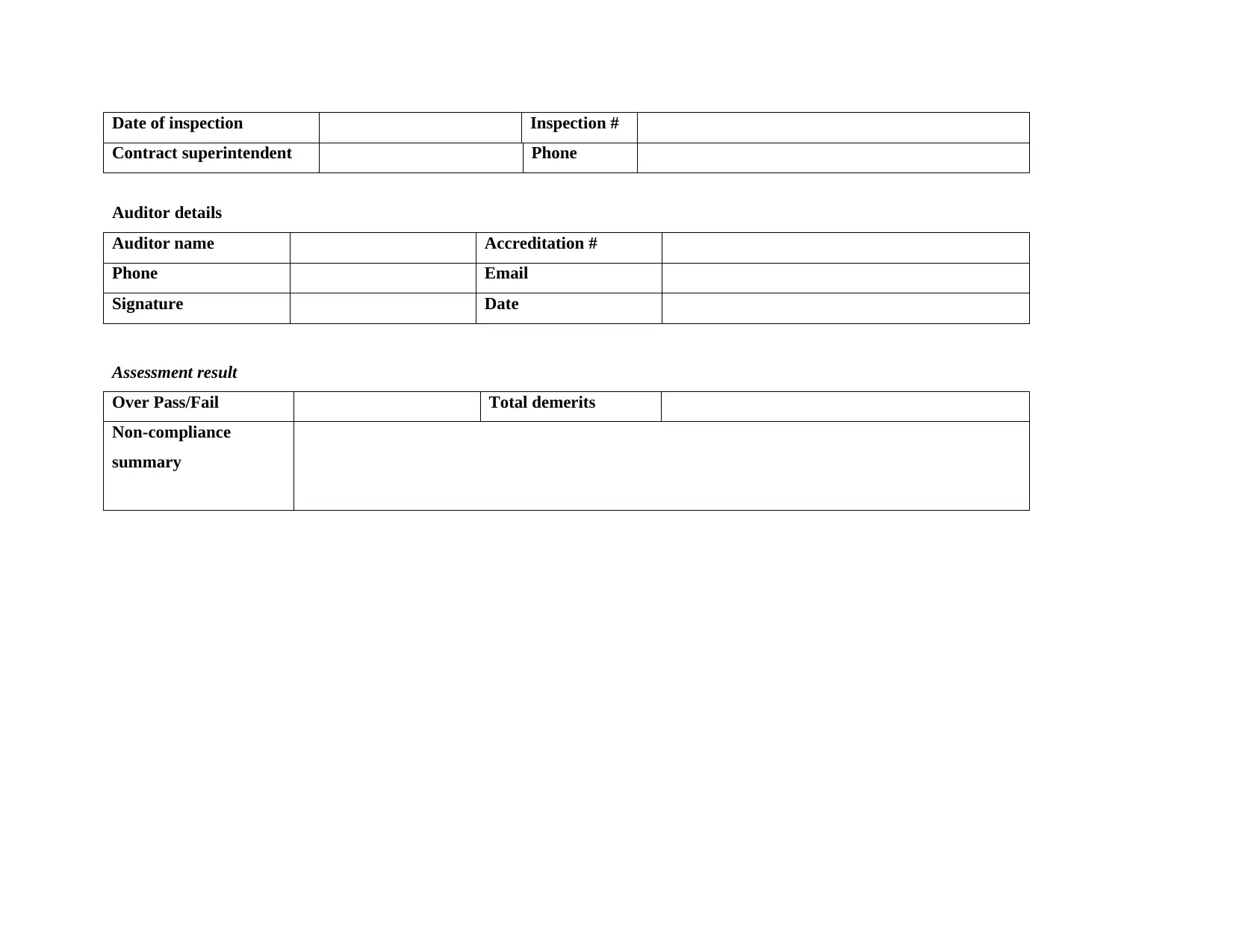
Date of inspection Inspection #
Contract superintendent Phone
Auditor details
Auditor name Accreditation #
Phone Email
Signature Date
Assessment result
Over Pass/Fail Total demerits
Non-compliance
summary
Contract superintendent Phone
Auditor details
Auditor name Accreditation #
Phone Email
Signature Date
Assessment result
Over Pass/Fail Total demerits
Non-compliance
summary
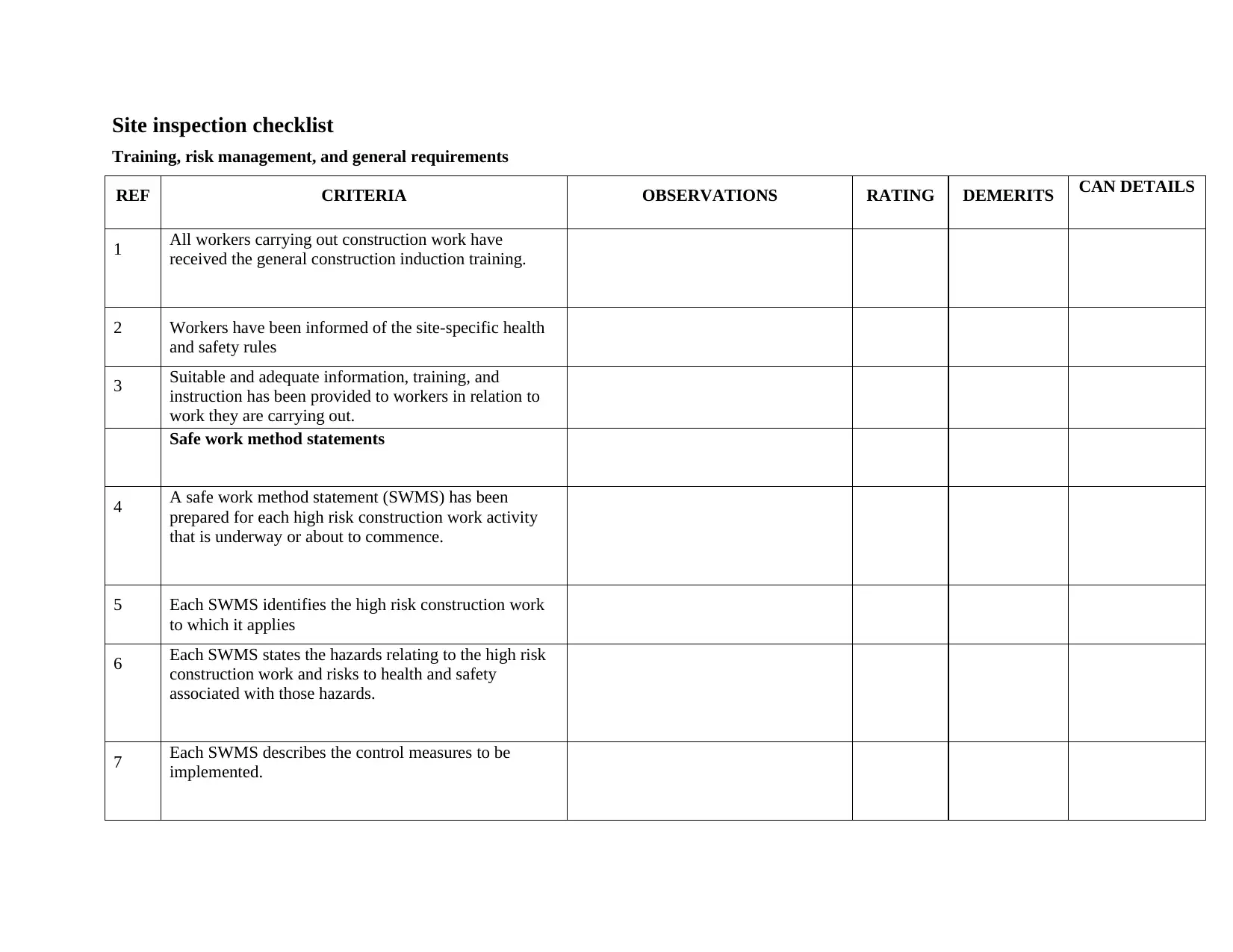
Site inspection checklist
Training, risk management, and general requirements
REF CRITERIA OBSERVATIONS RATING DEMERITS CAN DETAILS
1 All workers carrying out construction work have
received the general construction induction training.
2 Workers have been informed of the site-specific health
and safety rules
3 Suitable and adequate information, training, and
instruction has been provided to workers in relation to
work they are carrying out.
Safe work method statements
4 A safe work method statement (SWMS) has been
prepared for each high risk construction work activity
that is underway or about to commence.
5 Each SWMS identifies the high risk construction work
to which it applies
6 Each SWMS states the hazards relating to the high risk
construction work and risks to health and safety
associated with those hazards.
7 Each SWMS describes the control measures to be
implemented.
Training, risk management, and general requirements
REF CRITERIA OBSERVATIONS RATING DEMERITS CAN DETAILS
1 All workers carrying out construction work have
received the general construction induction training.
2 Workers have been informed of the site-specific health
and safety rules
3 Suitable and adequate information, training, and
instruction has been provided to workers in relation to
work they are carrying out.
Safe work method statements
4 A safe work method statement (SWMS) has been
prepared for each high risk construction work activity
that is underway or about to commence.
5 Each SWMS identifies the high risk construction work
to which it applies
6 Each SWMS states the hazards relating to the high risk
construction work and risks to health and safety
associated with those hazards.
7 Each SWMS describes the control measures to be
implemented.
⊘ This is a preview!⊘
Do you want full access?
Subscribe today to unlock all pages.

Trusted by 1+ million students worldwide
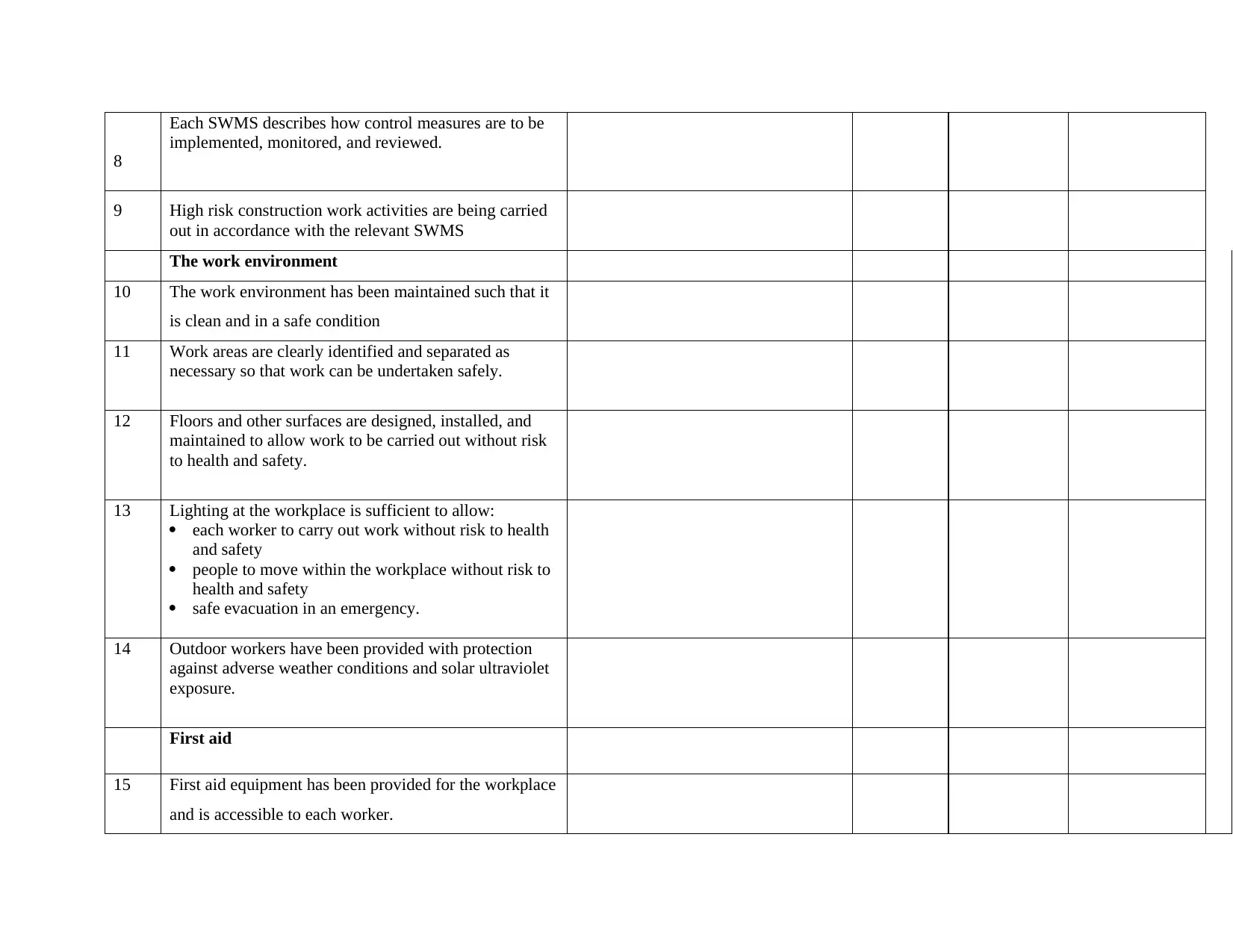
8
Each SWMS describes how control measures are to be
implemented, monitored, and reviewed.
9 High risk construction work activities are being carried
out in accordance with the relevant SWMS
The work environment
10 The work environment has been maintained such that it
is clean and in a safe condition
11 Work areas are clearly identified and separated as
necessary so that work can be undertaken safely.
12 Floors and other surfaces are designed, installed, and
maintained to allow work to be carried out without risk
to health and safety.
13 Lighting at the workplace is sufficient to allow:
each worker to carry out work without risk to health
and safety
people to move within the workplace without risk to
health and safety
safe evacuation in an emergency.
14 Outdoor workers have been provided with protection
against adverse weather conditions and solar ultraviolet
exposure.
First aid
15 First aid equipment has been provided for the workplace
and is accessible to each worker.
Each SWMS describes how control measures are to be
implemented, monitored, and reviewed.
9 High risk construction work activities are being carried
out in accordance with the relevant SWMS
The work environment
10 The work environment has been maintained such that it
is clean and in a safe condition
11 Work areas are clearly identified and separated as
necessary so that work can be undertaken safely.
12 Floors and other surfaces are designed, installed, and
maintained to allow work to be carried out without risk
to health and safety.
13 Lighting at the workplace is sufficient to allow:
each worker to carry out work without risk to health
and safety
people to move within the workplace without risk to
health and safety
safe evacuation in an emergency.
14 Outdoor workers have been provided with protection
against adverse weather conditions and solar ultraviolet
exposure.
First aid
15 First aid equipment has been provided for the workplace
and is accessible to each worker.
Paraphrase This Document
Need a fresh take? Get an instant paraphrase of this document with our AI Paraphraser
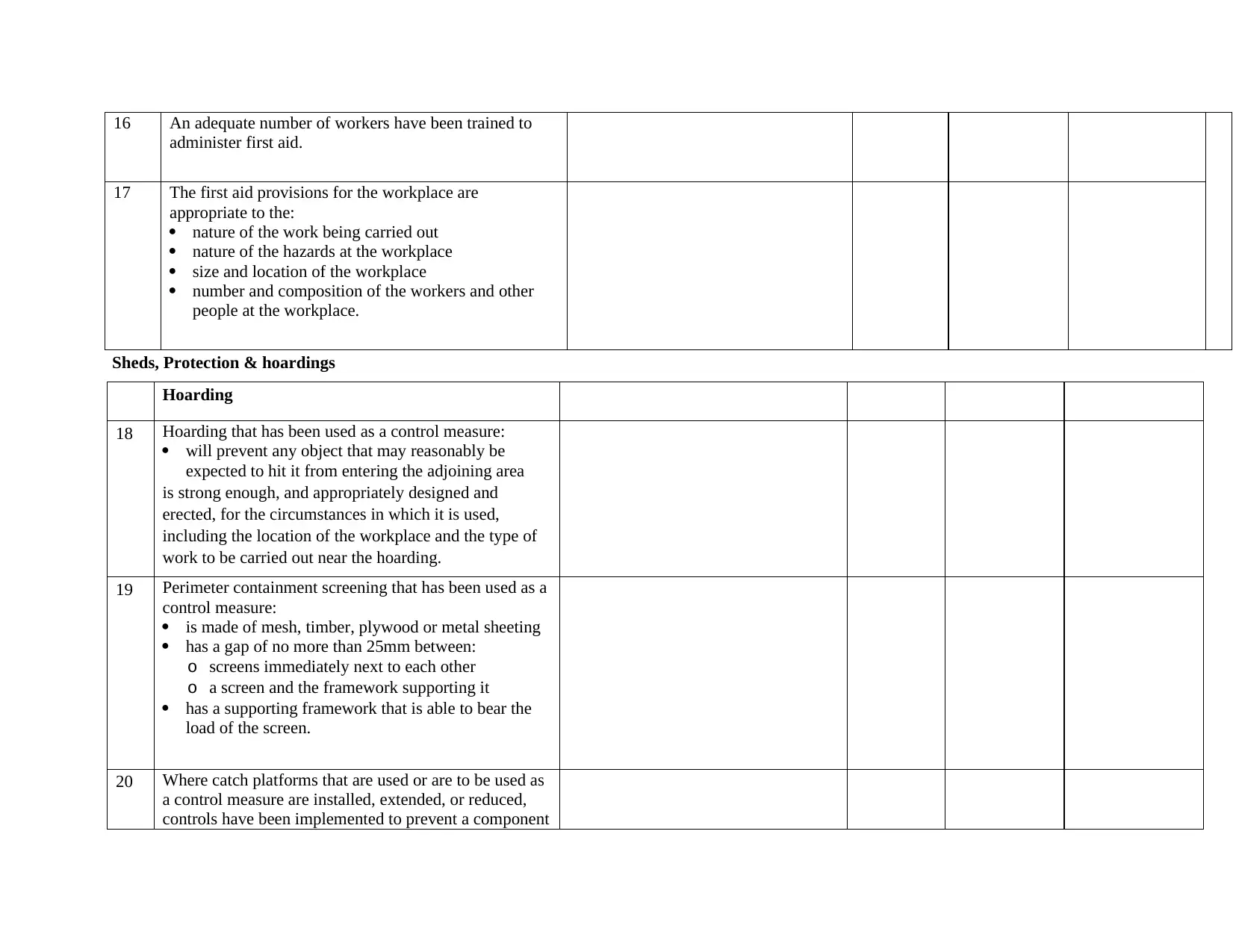
16 An adequate number of workers have been trained to
administer first aid.
17 The first aid provisions for the workplace are
appropriate to the:
nature of the work being carried out
nature of the hazards at the workplace
size and location of the workplace
number and composition of the workers and other
people at the workplace.
Sheds, Protection & hoardings
Hoarding
18 Hoarding that has been used as a control measure:
will prevent any object that may reasonably be
expected to hit it from entering the adjoining area
is strong enough, and appropriately designed and
erected, for the circumstances in which it is used,
including the location of the workplace and the type of
work to be carried out near the hoarding.
19 Perimeter containment screening that has been used as a
control measure:
is made of mesh, timber, plywood or metal sheeting
has a gap of no more than 25mm between:
o screens immediately next to each other
o a screen and the framework supporting it
has a supporting framework that is able to bear the
load of the screen.
20 Where catch platforms that are used or are to be used as
a control measure are installed, extended, or reduced,
controls have been implemented to prevent a component
administer first aid.
17 The first aid provisions for the workplace are
appropriate to the:
nature of the work being carried out
nature of the hazards at the workplace
size and location of the workplace
number and composition of the workers and other
people at the workplace.
Sheds, Protection & hoardings
Hoarding
18 Hoarding that has been used as a control measure:
will prevent any object that may reasonably be
expected to hit it from entering the adjoining area
is strong enough, and appropriately designed and
erected, for the circumstances in which it is used,
including the location of the workplace and the type of
work to be carried out near the hoarding.
19 Perimeter containment screening that has been used as a
control measure:
is made of mesh, timber, plywood or metal sheeting
has a gap of no more than 25mm between:
o screens immediately next to each other
o a screen and the framework supporting it
has a supporting framework that is able to bear the
load of the screen.
20 Where catch platforms that are used or are to be used as
a control measure are installed, extended, or reduced,
controls have been implemented to prevent a component
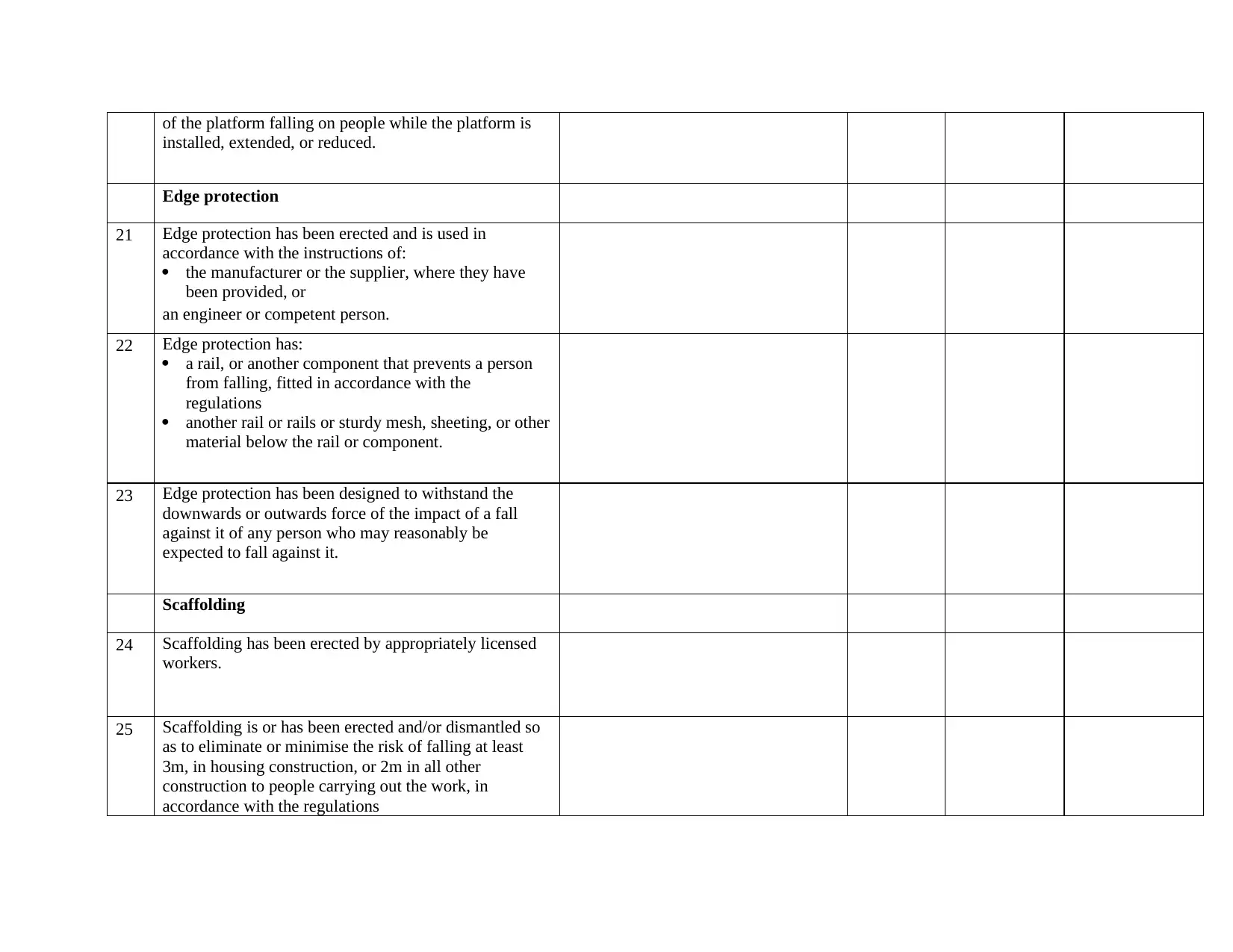
of the platform falling on people while the platform is
installed, extended, or reduced.
Edge protection
21 Edge protection has been erected and is used in
accordance with the instructions of:
the manufacturer or the supplier, where they have
been provided, or
an engineer or competent person.
22 Edge protection has:
a rail, or another component that prevents a person
from falling, fitted in accordance with the
regulations
another rail or rails or sturdy mesh, sheeting, or other
material below the rail or component.
23 Edge protection has been designed to withstand the
downwards or outwards force of the impact of a fall
against it of any person who may reasonably be
expected to fall against it.
Scaffolding
24 Scaffolding has been erected by appropriately licensed
workers.
25 Scaffolding is or has been erected and/or dismantled so
as to eliminate or minimise the risk of falling at least
3m, in housing construction, or 2m in all other
construction to people carrying out the work, in
accordance with the regulations
installed, extended, or reduced.
Edge protection
21 Edge protection has been erected and is used in
accordance with the instructions of:
the manufacturer or the supplier, where they have
been provided, or
an engineer or competent person.
22 Edge protection has:
a rail, or another component that prevents a person
from falling, fitted in accordance with the
regulations
another rail or rails or sturdy mesh, sheeting, or other
material below the rail or component.
23 Edge protection has been designed to withstand the
downwards or outwards force of the impact of a fall
against it of any person who may reasonably be
expected to fall against it.
Scaffolding
24 Scaffolding has been erected by appropriately licensed
workers.
25 Scaffolding is or has been erected and/or dismantled so
as to eliminate or minimise the risk of falling at least
3m, in housing construction, or 2m in all other
construction to people carrying out the work, in
accordance with the regulations
⊘ This is a preview!⊘
Do you want full access?
Subscribe today to unlock all pages.

Trusted by 1+ million students worldwide
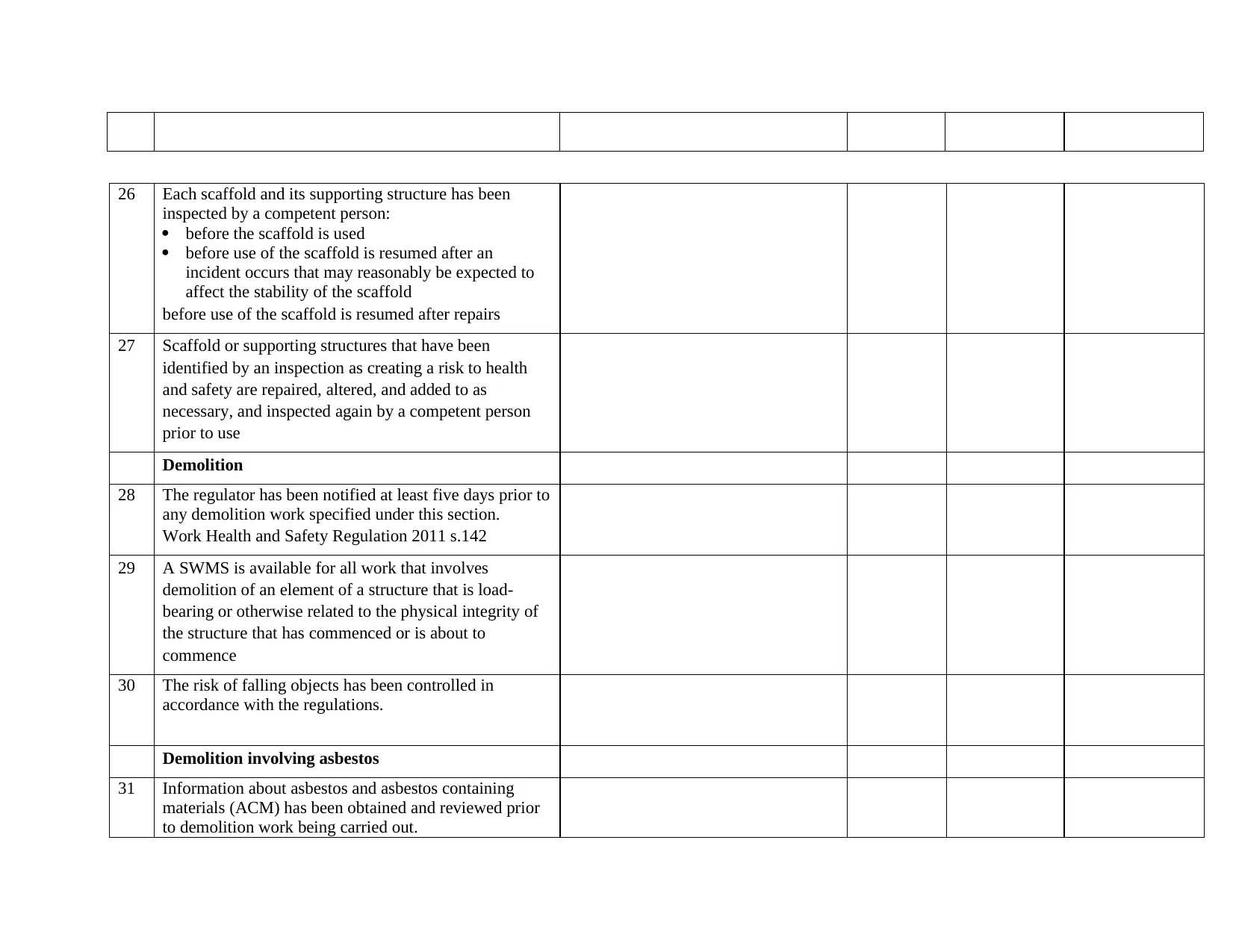
26 Each scaffold and its supporting structure has been
inspected by a competent person:
before the scaffold is used
before use of the scaffold is resumed after an
incident occurs that may reasonably be expected to
affect the stability of the scaffold
before use of the scaffold is resumed after repairs
27 Scaffold or supporting structures that have been
identified by an inspection as creating a risk to health
and safety are repaired, altered, and added to as
necessary, and inspected again by a competent person
prior to use
Demolition
28 The regulator has been notified at least five days prior to
any demolition work specified under this section.
Work Health and Safety Regulation 2011 s.142
29 A SWMS is available for all work that involves
demolition of an element of a structure that is load-
bearing or otherwise related to the physical integrity of
the structure that has commenced or is about to
commence
30 The risk of falling objects has been controlled in
accordance with the regulations.
Demolition involving asbestos
31 Information about asbestos and asbestos containing
materials (ACM) has been obtained and reviewed prior
to demolition work being carried out.
inspected by a competent person:
before the scaffold is used
before use of the scaffold is resumed after an
incident occurs that may reasonably be expected to
affect the stability of the scaffold
before use of the scaffold is resumed after repairs
27 Scaffold or supporting structures that have been
identified by an inspection as creating a risk to health
and safety are repaired, altered, and added to as
necessary, and inspected again by a competent person
prior to use
Demolition
28 The regulator has been notified at least five days prior to
any demolition work specified under this section.
Work Health and Safety Regulation 2011 s.142
29 A SWMS is available for all work that involves
demolition of an element of a structure that is load-
bearing or otherwise related to the physical integrity of
the structure that has commenced or is about to
commence
30 The risk of falling objects has been controlled in
accordance with the regulations.
Demolition involving asbestos
31 Information about asbestos and asbestos containing
materials (ACM) has been obtained and reviewed prior
to demolition work being carried out.
Paraphrase This Document
Need a fresh take? Get an instant paraphrase of this document with our AI Paraphraser
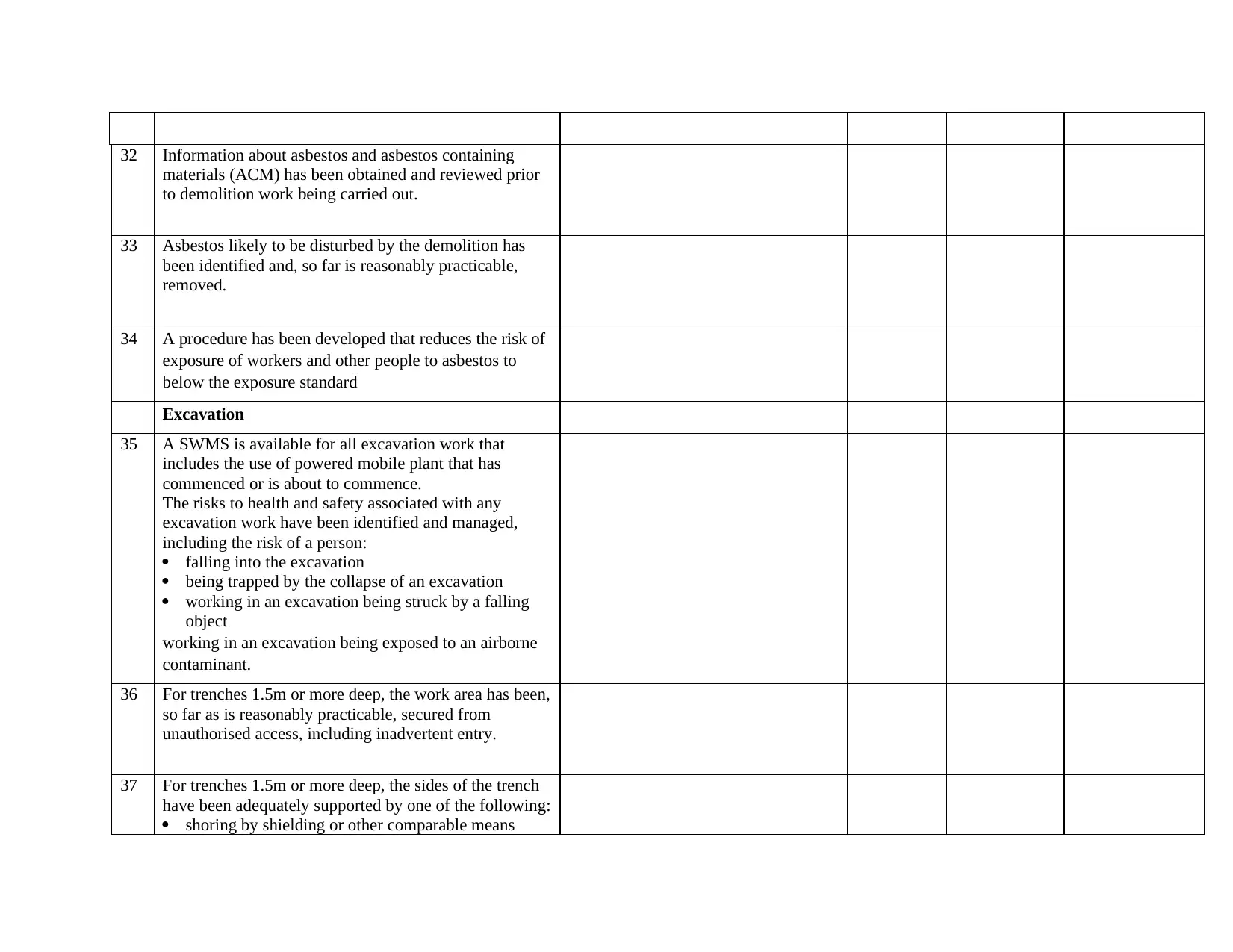
32 Information about asbestos and asbestos containing
materials (ACM) has been obtained and reviewed prior
to demolition work being carried out.
33 Asbestos likely to be disturbed by the demolition has
been identified and, so far is reasonably practicable,
removed.
34 A procedure has been developed that reduces the risk of
exposure of workers and other people to asbestos to
below the exposure standard
Excavation
35 A SWMS is available for all excavation work that
includes the use of powered mobile plant that has
commenced or is about to commence.
The risks to health and safety associated with any
excavation work have been identified and managed,
including the risk of a person:
falling into the excavation
being trapped by the collapse of an excavation
working in an excavation being struck by a falling
object
working in an excavation being exposed to an airborne
contaminant.
36 For trenches 1.5m or more deep, the work area has been,
so far as is reasonably practicable, secured from
unauthorised access, including inadvertent entry.
37 For trenches 1.5m or more deep, the sides of the trench
have been adequately supported by one of the following:
shoring by shielding or other comparable means
materials (ACM) has been obtained and reviewed prior
to demolition work being carried out.
33 Asbestos likely to be disturbed by the demolition has
been identified and, so far is reasonably practicable,
removed.
34 A procedure has been developed that reduces the risk of
exposure of workers and other people to asbestos to
below the exposure standard
Excavation
35 A SWMS is available for all excavation work that
includes the use of powered mobile plant that has
commenced or is about to commence.
The risks to health and safety associated with any
excavation work have been identified and managed,
including the risk of a person:
falling into the excavation
being trapped by the collapse of an excavation
working in an excavation being struck by a falling
object
working in an excavation being exposed to an airborne
contaminant.
36 For trenches 1.5m or more deep, the work area has been,
so far as is reasonably practicable, secured from
unauthorised access, including inadvertent entry.
37 For trenches 1.5m or more deep, the sides of the trench
have been adequately supported by one of the following:
shoring by shielding or other comparable means

benching
battering.
Note: This does not apply if PCBU has written advice,
which complies with the regulations, from a
geotechnical engineer that all sides of the trench are safe
from collapse has been obtained.
Electrical
39 Work is conducted in a way that is electrically safe.
40 A SWMS is available for all work that is carried out on
or near energised electrical installations or services that
has commenced or is about to commence at the
workplace.
41 Electrical leads are arranged to avoid damage.
42 Electrical work is carried out by an appropriately
licensed individual
43 Leads and tools are not used in damp or wet conditions
unless they have been specifically designed to do so.
Formwork
44 The formwork system has been certified by:
a formwork designer, for basic formwork systems, or
an engineer, for non-basic formwork systems.
45 The necessary formwork documentation, including
formwork drawings, has been prepared and is available
for inspection on site
battering.
Note: This does not apply if PCBU has written advice,
which complies with the regulations, from a
geotechnical engineer that all sides of the trench are safe
from collapse has been obtained.
Electrical
39 Work is conducted in a way that is electrically safe.
40 A SWMS is available for all work that is carried out on
or near energised electrical installations or services that
has commenced or is about to commence at the
workplace.
41 Electrical leads are arranged to avoid damage.
42 Electrical work is carried out by an appropriately
licensed individual
43 Leads and tools are not used in damp or wet conditions
unless they have been specifically designed to do so.
Formwork
44 The formwork system has been certified by:
a formwork designer, for basic formwork systems, or
an engineer, for non-basic formwork systems.
45 The necessary formwork documentation, including
formwork drawings, has been prepared and is available
for inspection on site
⊘ This is a preview!⊘
Do you want full access?
Subscribe today to unlock all pages.

Trusted by 1+ million students worldwide

47 On-site inspections are carried out to ensure compliance
with the formwork system
Hazardous substances and dangerous goods
48 The risks to health and safety associated with any
hazardous chemicals used, handled, generated, or stored
at the workplace have been identified and managed,
including the risk:
of a physical or chemical reaction
of fire or explosion
that a chemical may become unstable
49 Controls implemented to eliminate or minimise the risks
associated with hazardous chemicals are reviewed and
revised in accordance with the regulations
50 All hazardous chemicals that are used, handled, or
stored at the workplace are correctly labelled.
51 A register of hazardous chemicals used, handled, or
stored at the workplace has been prepared in accordance
with the regulations and is kept at the workplace.
52 A spill containment system has been implemented in
each part of the workplace where there is a risk from a
spill or leak of a hazardous chemical.
53 Fire protection and fire fighting equipment that has been
designed and built for the types of hazardous chemicals
at the workplace have been provided.
Emergency equipment is available at the workplace.
54 Workers have been provided information about any
with the formwork system
Hazardous substances and dangerous goods
48 The risks to health and safety associated with any
hazardous chemicals used, handled, generated, or stored
at the workplace have been identified and managed,
including the risk:
of a physical or chemical reaction
of fire or explosion
that a chemical may become unstable
49 Controls implemented to eliminate or minimise the risks
associated with hazardous chemicals are reviewed and
revised in accordance with the regulations
50 All hazardous chemicals that are used, handled, or
stored at the workplace are correctly labelled.
51 A register of hazardous chemicals used, handled, or
stored at the workplace has been prepared in accordance
with the regulations and is kept at the workplace.
52 A spill containment system has been implemented in
each part of the workplace where there is a risk from a
spill or leak of a hazardous chemical.
53 Fire protection and fire fighting equipment that has been
designed and built for the types of hazardous chemicals
at the workplace have been provided.
Emergency equipment is available at the workplace.
54 Workers have been provided information about any
Paraphrase This Document
Need a fresh take? Get an instant paraphrase of this document with our AI Paraphraser
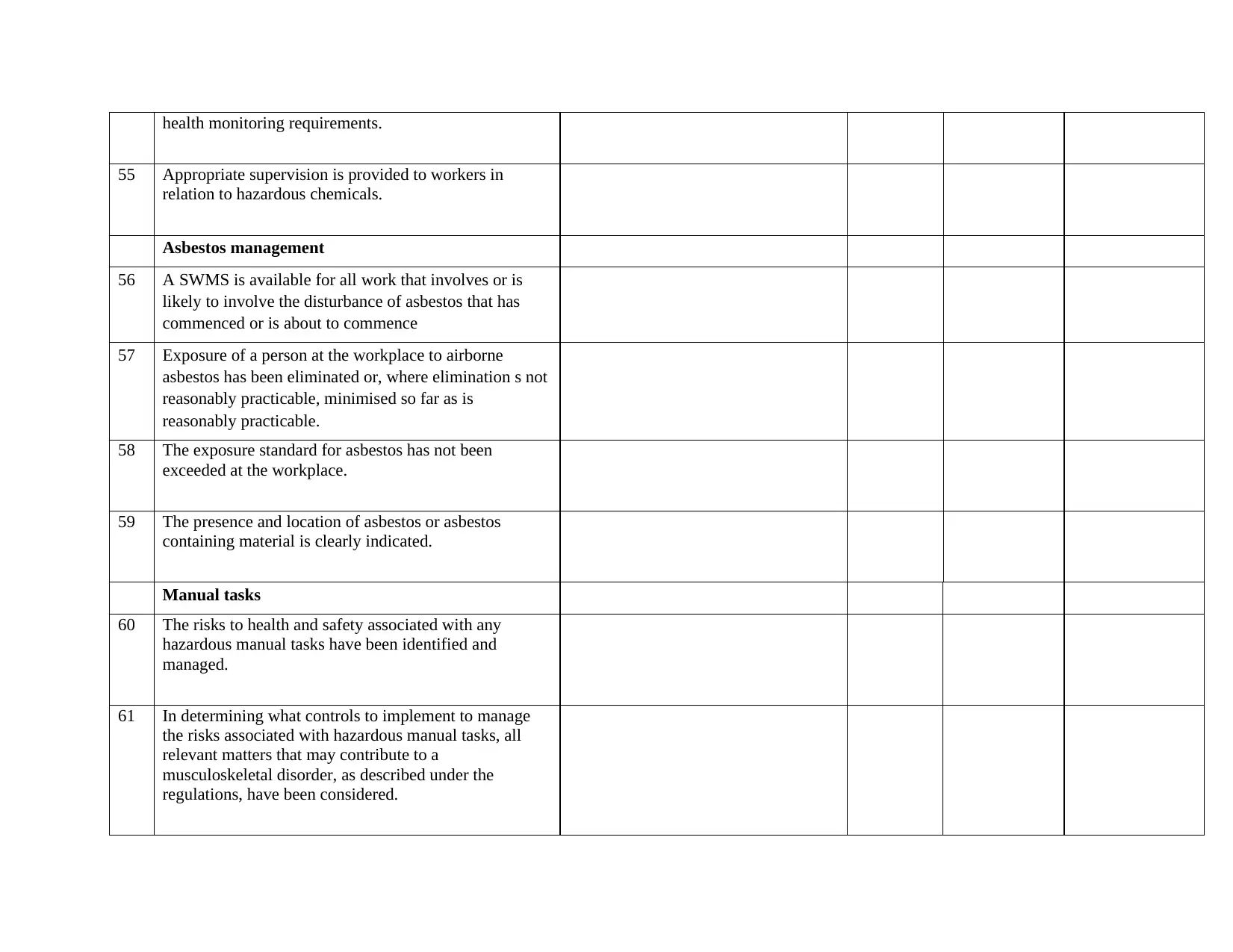
health monitoring requirements.
55 Appropriate supervision is provided to workers in
relation to hazardous chemicals.
Asbestos management
56 A SWMS is available for all work that involves or is
likely to involve the disturbance of asbestos that has
commenced or is about to commence
57 Exposure of a person at the workplace to airborne
asbestos has been eliminated or, where elimination s not
reasonably practicable, minimised so far as is
reasonably practicable.
58 The exposure standard for asbestos has not been
exceeded at the workplace.
59 The presence and location of asbestos or asbestos
containing material is clearly indicated.
Manual tasks
60 The risks to health and safety associated with any
hazardous manual tasks have been identified and
managed.
61 In determining what controls to implement to manage
the risks associated with hazardous manual tasks, all
relevant matters that may contribute to a
musculoskeletal disorder, as described under the
regulations, have been considered.
55 Appropriate supervision is provided to workers in
relation to hazardous chemicals.
Asbestos management
56 A SWMS is available for all work that involves or is
likely to involve the disturbance of asbestos that has
commenced or is about to commence
57 Exposure of a person at the workplace to airborne
asbestos has been eliminated or, where elimination s not
reasonably practicable, minimised so far as is
reasonably practicable.
58 The exposure standard for asbestos has not been
exceeded at the workplace.
59 The presence and location of asbestos or asbestos
containing material is clearly indicated.
Manual tasks
60 The risks to health and safety associated with any
hazardous manual tasks have been identified and
managed.
61 In determining what controls to implement to manage
the risks associated with hazardous manual tasks, all
relevant matters that may contribute to a
musculoskeletal disorder, as described under the
regulations, have been considered.

Welding
62 Workers are not exposed to welding fumes that contain
a substance or mixture in an airborne concentration that
exceeds the exposure standard for the substance or
mixture.
63 Non-flammable screens or partitions have been installed
where appropriate
64 The risk of electric shock from contact with the
electrode, live parts, the work piece, or through contact
with an unearthed cable, lead, or tool has been
controlled.
65 Welding equipment is used with earth leakage current
protection by means of a residual current device.
Safety nets
66 Safety nets used as a control measure must:
be designed by an engineer or competent person for
the purpose for which it is intended to be used
be made from a material designed to minimise injury
to a person falling into the net
have energy absorbing characteristics to reduce the
shock or injury to a person falling into the net.
67 Each safety net has been installed:
so that a person falling into the net will not hit
anything below the net
as close as possible below the surface from which
people might fall, but not more than the distance
specified by the manufacturer or supplier or, where
the manufacturer or supplier has not specified a
distance, an engineer or competent person.
62 Workers are not exposed to welding fumes that contain
a substance or mixture in an airborne concentration that
exceeds the exposure standard for the substance or
mixture.
63 Non-flammable screens or partitions have been installed
where appropriate
64 The risk of electric shock from contact with the
electrode, live parts, the work piece, or through contact
with an unearthed cable, lead, or tool has been
controlled.
65 Welding equipment is used with earth leakage current
protection by means of a residual current device.
Safety nets
66 Safety nets used as a control measure must:
be designed by an engineer or competent person for
the purpose for which it is intended to be used
be made from a material designed to minimise injury
to a person falling into the net
have energy absorbing characteristics to reduce the
shock or injury to a person falling into the net.
67 Each safety net has been installed:
so that a person falling into the net will not hit
anything below the net
as close as possible below the surface from which
people might fall, but not more than the distance
specified by the manufacturer or supplier or, where
the manufacturer or supplier has not specified a
distance, an engineer or competent person.
⊘ This is a preview!⊘
Do you want full access?
Subscribe today to unlock all pages.

Trusted by 1+ million students worldwide
1 out of 15
Related Documents
Your All-in-One AI-Powered Toolkit for Academic Success.
+13062052269
info@desklib.com
Available 24*7 on WhatsApp / Email
![[object Object]](/_next/static/media/star-bottom.7253800d.svg)
Unlock your academic potential
Copyright © 2020–2025 A2Z Services. All Rights Reserved. Developed and managed by ZUCOL.





